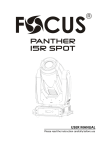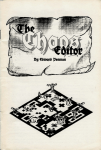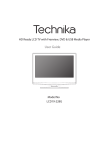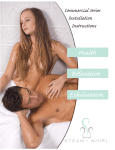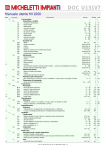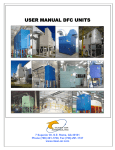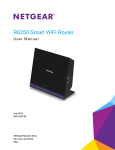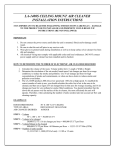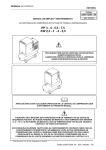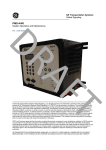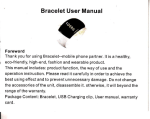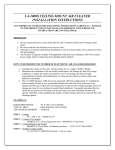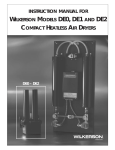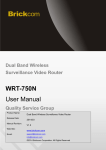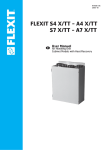Download HP 10 - 15 KW 7,5 - 11 - Air Compressors Direct
Transcript
ENGLISH Code 2200772314 04 INSTRUCTION AND MAINTENANCE MANUAL Edition 08/2006 QUIET ROTARY SCREW (QRS) COMPRESSOR UNITS HP 10 - 15 KW 7,5 - 11 NEW DRYER: FOR INSTALLATION SEE PAG. 40 THIS MACHINE MUST BE CONNECTED TO TWO DIFFERENT POWER SUPPLIES: THREE-PHASE OR SINGLE-PHASE SUPPLY FOR THE COMPRESSOR SINGLE-PHASE SUPPLY FOR THE DRYER READ THIS MANUAL CAREFULLY BEFORE CARRYING OUT ANY OPERATIONS ON THE COMPRESSOR UNIT. THIS MACHINE IS DESIGNED FOR BOTH CONTINUOUS AND INTERMITTENT OPERATION. HOWEVER, TO AVOID CONDENSATION PROBLEMS IN THE OIL, THE MACHINE MUST OPERATE WITH AT LEAST 10% OF ITS TOTAL CAPACITY. CHECK FOR SIGNS OF CONDENSATION IN THE OIL BY FOLLOWING THE INSTRUCTIONS GIVEN IN SECTION 15.2 . Cod. 2200772314 04 - Edition 08/2006 - 1 ENGLISH CONTENTS PART A: INFORMATION FOR THE USER 1.0 GENERAL CHARACTERISTICS 2.0 INTENDED USE 3.0 OPERATION 4.0 GENERAL SAFETY STANDARDS 5.0 DESCRIPTION OF WARNING LABELS 6.0 DANGER ZONES 7.0 SAFETY DEVICES 8.0 POSITION OF WARNING LABELS 9.0 COMPRESSOR ROOM 10.0 TRANSPORT AND HANDLING 11.0 UNPACKING 12.0 INSTALLATION 13.0 DIMENSIONS AND TECHNICAL DATA 14.0 MACHINE ILLUSTRATION 15.0 ORDINARY MAINTENANCE TO BE DONE BY THE USER 16.0 PERIODS OF INACTIVITY 17.0 SCRAPPING THE UNIT 18.0 LIST OF SPARE PARTS FOR ROUTINE MAINTENANCE 19.0 TROUBLE-SHOOTING AND EMERGENCY REPAIRS PART B: INFORMATION RESERVED FOR TECHNICALLY SKILLED PERSONNEL 20.0 STARTING UP 21.0 GENERAL ORDINARY MAINTENANCE REQUIRES TRAINED PERSONNEL 22.0 CHANGING THE OIL 23.0 CHANGING THE OIL SEPARATING FILTER 24.0 BELT TENSION 25.0 REPLACING THE BELT 26.0 FLOW DIAGRAM 27.0 PRESSURE SWITCH ADJUSTMENT 28.0 DRYER CALIBRATIONS 29.0 VOLTAGE CONVERSION WIRING DIAGRAM (ON THE BACK COVER) IMPORTANT: A COPY OF THE WIRING DIAGRAMS CAN BE FOUND INSIDE THE ELECTRIC BOARD OF THE COMPRESSOR. QUIET ROTARY SCREW COMPRESSOR UNITS HP 10 - 15 KW 7,5 - 11 MACHINE AND MANUFACTURER IDENTIFICATION DATA FIG. 1 1 1 Position of the identification plate Fig. 1 2 - Edition 08/2006 Cod. 2200772314 04 - ENGLISH FOR TECHNICAL ASSISTANCE In the event of breakdown or malfunction of the machine, switch it off and do not tamper with it. If repairs are needed, apply only to a technical assistance centre approved by the manufacturer and insist on the use of genuine Atlas Copco spare parts. Failure to comply with the above may endanger the safety of the machine. INTRODUCTION Keep this manual with care for future consultation; the use and maintenance manual is an integral part of the machine. Read this manual carefully before carrying out any operations on the compressor unit. The installation of the compressor unit and all operations involving it must be performed in conformity with the regulations in force concerning electric plants and personal safety. CHARACTERISTICS AND SAFETY PRECAUTIONS MACHINE WITH AUTOMATIC START BEFORE REMOVING THE PROTECTIVE GUARDS TO CARRY OUT ANY MAINTENANCE ON THE MACHINE, SWITCH OFF THE ELECTRIC POWER SUPPLY AND DISCHARGE THE RESIDUAL PRESSURE INSIDE THE UNIT. ALL ELECTRIC WORK ON THE MACHINE, HOWEVER SLIGHT, SHOULD BE CARRIED OUT BY PROFESSIONALLY TRAINED PERSONNEL. - To prevent internal corrosion, which could compromise the safety of the compressed air tank, the condensation that is produced must be discharged at least once a week. - The thickness of the tank should be controlled against legislation currently in force in the country where the tank is installed. - The tank cannot be used and must be replaced if the thickness falls below the level given in the instruction documents for the tank. - The tank can be used within the temperature limits given in the conformity declaration. The manufacturer does not accept respons bility for damage caused as a result of negligence of failure to abide by the instructions given above. THIS MACHINE IS NOT SUITABLE FOR EXTERNAL INSTALLATION THIS MACHINE CORRESPOND TO THE ESSENTIAL SAFETY REQUIREMENTS FORESEEN FROM THE EUROPEAN STANDARD (98/37 CE), AND THE RULE EN 292 1.0 GENERAL CHARACTERISTICS The compressor units use single-stage screw rotary air compressors with oil injection. The system is self-bearing and does not require bolts or other devices to anchor it to the floor. The unit is completely assembled in the factory; the necessary connections for setting it up are: • connection to the power mains (see installation chapter) • connection to the compressed air network (see installation chapter) 2.0 INTENDED USE The compressor has been built to supply compressed air for industrial use. The machine cannot be used in premises where there is a risk of fire or explosion or where work is carried out which releases substances into the environment which are dangerous with regard to safety (for example: solvents, flammable vapours, alcohol, etc.). In particular the compressor cannot be used to produce air to be breathed by humans or used on direct contact with foodstuffs. These uses are allowed if the compressed air produced is filtered by means of a suitable filtering system (Consult the manufacturer for these special uses.) This compressor must be used only for the purpose for which it was specifically designed. All other uses are to be considered incorrect and therefore unreasonable. The Manufacturer cannot be held responsible for any damage resulting from improper, incorrect or unreasonable use. The lubricating liquids and other eventual fluids must not be discharged in the environment. These polluting and hazardous products must compulsory be disposed by charging authorised and specialised firms according to the different typology of product. Differentiate the compressor components according to the different construction materials (plastic, copper, iron, oil filter, air filter ecc…) . Cod. 2200772314 04 - Edition 08/2006 - 3 ENGLISH 3.0 OPERATION 3.1 OPERATION FOR COMPRESSOR The electric motor and the compressor unit are coupled by means of a belt transmission. The compressor unit takes in the outside air through the suction valve. The intake air is filtered by the filter cartridge fitted upstream from the intake valve. Inside the compressor unit, the air and the lubricating oil are compressed and sent to the oil separating tank where the oil is separated from the compressed air; the air is then filtered again by the oil separating cartridge to reduce the amount of suspended oil particles to a minimum. The machine is fitted with a suitable air-cooling system. The machine is protected by a special safety thermostat: if the oil temperature reaches 105 ÷ 110 °C the machine cuts out automatically. 3.2 OPERATION FOR DRYER Air flows from the tank to the drier and is then dried and sent to the distribution network. Dryer operation is described below. The gaseous refrigerant coming from the evaporator (4) is sucked by the refrigeration compressor (1) and it is pumped into the condenser (2). This allows its condensation, eventually with the help of the fan (3); the condensed refrigerant passes through the dewatering filter (8) and it expands through the capillary tube (7) and goes back to the evaporator where it produces the refrigerating effect. Due to the heat exchange with the compressed air which passes through the evaporator against the stream, the refrigerant evaporates and goes back to the compressor for a new cycle. The circuit is equipped with a bypass system for the refrigerant; this intervenes to adjust the available refrigerating capacity to the actual cooling load. This is achieved by injecting hot gas under the control of the valve (9): this valve keeps constant the pressure of the refrigerant in the evaporator and therefore also the dew point never decreases below 0 °C in order to prevent the condensate from freezing inside the evaporator. The drier runs completely automatically; it is calibrated in the factory for a dew point of ~ 3 °C and therefore no further calibrations are required. DRYER FLOW DIAGRAM AIR OUTLET AIR INLET CONDENSATE DRAIN 4.0 GENERAL SAFETY STANDARDS The compressor may be used only by specially trained and authorized personnel. Any tampering with the machine or alterations not approved beforehand by the Manufacturer relieve the latter of responsibility for any damage resulting from the above actions. The removal of or tampering with the safety devices constitutes a violation of the European Standards on safety. ATTENTION: UPSTREAM OF THE MACHINE INSTALLAN ISOLATOR KNIFE-SWITCH WITH AN AUTOMATIC CUTOUT AGAINST CURRENT SURGES AND EQUIPPED WITH A DIFFERENTIAL DEVICE FOR CALIBRATIONS SEE WIRING DIAGRAM ON LAST PAGE ALL ELECTRIC WORK ON THE MACHINE, HOWERE SLIGHT, SHOULD BE CARRIED OUT BY PROFESSIONALLY TRAINED PERSONNEL. 4 - Edition 08/2006 Cod. 2200772314 04 - ENGLISH 5.0 DESCRIPTION OF WARMING LABELS 1) FLUID EJECTION 6) HIGH PRESSURE 2) DANGEROUS ELECTRIC VOLTAGE 7) HOT PARTS 3) AIR NOT FIT FOR BREATHING 8) MOVING PARTS 4) NOISE 9) FAN ROTATING 10) PURGE EVERY WEEK 5) MACHINE WITH AUTOMATIC START 5.1 DESCRIPTION OF COMPULSORY SIGNALS 11) READ THE USE AND MAINTENANCE INSTRUCTIONS 6.0 DANGERS ZONES 6.1 DANGERS ZONES FOR COMPRESSOR UNIT Risks present on the whole machine FIG. 3 (2) (8) (9) (2) (1) . Cod. 2200772314 04 - Edition 08/2006 - 5 ENGLISH 6.2 DANGERS ZONES FOR DRYER UNIT AND TANK Risks present on the whole machine FIG. 3A (2) (3) (6) (2) (2) (1) (9) (6) (3) (1) (6) 7.0 SAFETY DEVICES 7.1 SAFETY DEVICES FOR SCREW COMPRESSOR (Fig. 4) 1) 2) 3) 4) 5) 6) Safety screws The front protection can be opened with a special key Fixed protection device - cooling fan / pulley Safety valve Emergency stop Oil filling cover (with safety breather) 6 - Edition 08/2006 Cod. 2200772314 04 - ENGLISH FIG. 4 1 5 3 4 2 1 1 6 7.2 SAFETY DEVICES FOR DRYER UNIT AND TANK 1) 2) 3) 4) 5) Safety valve Protective switch cover Protective pressure switch cover Relay for refrigerant compressor (automatic) Overload protector for refrigerant compressor FIG. 5 2 1 4 5 . Cod. 2200772314 04 - Edition 08/2006 - 7 ENGLISH 8.0 POSITION OF WARNING LABELS 8.1 POSITION OF THE WARNING LABELS FOR COMPRESSOR UNIT The plates fitted on the compressor unit are part of the machine; they have been applied for safety purposes and must not be removed or spoiled for any reason. 1) Dangers plate Code 2202260791 4) Electrical label Code 2202722100 2) Plate “Machine with automatic start” Code 2202260791 5) Electrical label 3) Electrical label FIG. 6 1 1 2 2 3 4 3 5 4 5 8.2 POSITION OF WARNING LABELS FOR DRYER UNIT AND TANK The warning labels on the dryer unit are part of the machine; they have been applied for safety purposes and must not be removed or damaged for any reason. 1) Connector fixing data label Code D50322 3) Electrical label Code 2202711200 2) Dangers label Code D10806 FIG. 7 2 3 1 1 8 - Edition 08/2006 Cod. 2200772314 04 - 2 3 ENGLISH 8.3 POSITION OF THE DATA PLATE FOR COMPRESSOR UNIT FIG. 8 1 1 3 2 3 5 2 4 6 1 6 2 . 3 4 5 Cod. 2200772314 04 - Edition 08/2006 - 9 ENGLISH 8.4 POSITION OF THE DATA PLATE FOR DRYER – AIR RECEIVER FIG. 9 2 3 4 1 5 5 5 2 1 3 4 9.0 COMPRESSOR ROOM 9.1 FLOOR The floor must be even and of industrial type; the total weight of the machine is shown in the Chap. 13.0 Remember the total weight of the machine when positioning it. 9.2 VENTILATION When the machine is operating, the room temperature must not be higher than 40 °C or lower than 5 °C. 3 The volume of the room must be about 30 m 2 The room must be provided with 2 openings for ventilation with a surface area of about 0,5 m each. The first opening must be in a high position to evacuate the hot air, the second opening must be low to allow the intake of external air for ventilation. If the environment is dusty it is advisable to fit a filtering panel on this opening. 9.3 EXAMPLES OF VENTILATION OF THE COMPRESSOR ROOM FIG. 10 FAN AIR OUTPUT (IF NEEDED) Warm Air Discharge 10 - Edition 08/2006 Cod. 2200772314 04 - Cool Air Inlet ENGLISH 10.0 TRANSPORT AND HANDLING The machine must be transported as shown in the following figures. FIG. 11 L= m.6 (18 ft) minimum Tapes ISO 4878 Spacer bar for protection body Spacer bar for protection body Attention: it is recommended of to position the tape like specific in figure. 11.0 UNPACKING After removing the packing, ensure that the machine is unbroken and that there are no visibly damaged parts. If you are in doubt, do not use the machine but apply to the manufacturer technical assistance service or to your dealer. The packing material (plastic bags, polystyrene foam, nails, screws, wood, metal strapping, etc..) must not be left within the reach of children or abandoned in the environment, as they are a potential source of danger and pollution. Dispose of these materials in the approved collection centres. . Cod. 2200772314 04 - Edition 08/2006 - 11 ENGLISH 12.0 INSTALLATION 12.1 POSITIONING After unpacking the equipment and preparing the compressor room, put the machine into position, checking the following items: ● Ensure that there is sufficient space around the machine to allow maintenance (see Fig. 12). ● Check that the compressor is standing on a perfectly flat floor. FIG. 12 2 1 MINIMUM mt. 2 (6 ft) 1 MINIMUM mt. 2 (6 ft) 4 3 PROTECT THE POWER CABLE WITH A SUITABLE CONDUIT 3 SPACE FOR MAINTENANCE MINIMUM mt 1,5 (4,5 ft) SINGLE-PHASE DRYER SUPPLY LEAD THREE-PHASE OR SINGLE-PHASE ROTARY SCREW-COMPRESSOR SUPPLY LEAD. ENSURE THAT THE OPERATOR CAN SEE THE WHOLE MACHINE FROM THE CONTROL PANEL AND CHECK THE PRESENCE OF ANY UNAUTHORIZED PERSONS IN THE VICINITY OF THE MACHINE. 12.2 ELECTRICAL CONNECTION • Check that the supply voltage is the same as the value indicated on the machine data plate. CAUTION: the compressor Ref. 3 and the dryer Ref. 4 have two separate feeds, respectively three-phase or single-phase and single-phase. • Check the condition of the line leads and ensure that there is an efficient earth lead. • Ensure that there is an automatic cut-out device upstream for the machine against overcurrents, with a differential device (see Ref. 1 for compresseur Ref. 2 for dryer ) wiring diagram. • Connect the machine power cables with the greatest care, according to the standards in force. These cables must be as indicated on the machine wiring diagram. ONLY PROFESSIONALLY TRAINED PERSONNEL MAY HAVE ACCESS TO THE ELECTRIC PANEL. SWITCH OFF THE POWER BEFORE OPENING THE DOOR OF THE ELECTRIC PANEL. COMPLIANCE WITH THE REGULATIONS IN FORCE CONCERNING ELECTRIC PLANTS IS FUNDAMENTAL FOR OPERATOR SAFETY AND FOR THE PROTECTION OF THE MACHINE. 12 - Edition 08/2006 Cod. 2200772314 04 - ENGLISH CABLES, PLUGS AND ALL OTHER TYPE OF ELECTRIC MATERIAL USED FOR THE CONNECTION MUST BE SUITABLE FOR THE USE AND COMPLYING WITH THE REQUIREMENTS STATED BY THE REGULATIONS IN FORCE. 12.3 CONNECTION TO THE COMPRESSED AIR NETWORK Fit a manual interception valve Ref. 1 between the machine and the compressed air network so that the compressor may be isolated during maintenance operations; (see figure 13 ) . PIPES, FITTINGS AND CONNECTIONS USED FOR THE CONNECTION OF THE COMPRESSOR TO THE COMPRESSED AIR NETWORK MUST BE SUITABLE TO THE USE ACCORDING TO THE PRESCRIPTIONS OF THE REGULATIONS IN FORCE IN THE COUNTRY OF USE. ALL DAMAGE DUE TO THE FAILURE TO COMPLY WITH THESE INDICATIONS CANNOT BE ATTRIBUTED TO THE MANUFACTURER AND MAY CAUSE INVALIDITY OF THE GUARANTEE CONDITIONS. 1 FIG. 13 ALWAYS USE A FLEXIBLE PIPE 3 2 2 1 The manual drainage (Ref. 2 Fig. 13) the condensate automatic drain (Ref. 3 Fig. 13) are led outside the machine with a flexible pipe that may be inspected. Drainage must comply with the local regulations in force. ALL DAMAGE DUE TO THE FAILURE TO COMPLY WITH THESE INDICATIONS CANNOT BE ATTRIBUTED TO THE MANUFACTURER AND MAY CAUSE INVALIDITY OF THE GUARANTEE CONDITIONS. 12.4 STARTING UP See part B of this manual, Chpter 20.0 . Cod. 2200772314 04 - Edition 08/2006 - 13 ENGLISH 13.0 DIMENSIONS AND TECHNICAL DATA W W H H L L HP 10-15 KW 7,5-11 Dimensions (mm) L W 1935 620 H 1463 Air connetion HP 10-15 KW 7,5-11 ½” Dimensions (mm) L W 1935 620 H 1463 Air connetion ½” HP 10 kW 7,5 HP 15 kW 11 HP 10 kW 7,5 HP 15 kW 11 10 10 9,1 9,1 Standard air capacity l/min. 920 1310 1020 1440 Net weigt Kg. (with dryer) 335 349 335 349 Net weigt Kg. (without dryer) 292,5 305 292,5 305 Net weigt Kg. (on base) 167,5 180 167,5 180 Setting pressure bar(e) 105 ÷ 110 (permanent setting) Setting termostat °C Oil Capacity Liters ~3 ~3 ~3 ~3 Noiose product. dB(A) 66 68 66 68 14 - Edition 08/2006 Cod. 2200772314 04 - ENGLISH TYPE DRYER D3 D4 Weight Kg. R 134a Kg. 50 Hz 0,450 0,500 39 48 Nominal Power W 60 Hz 0,400 0,500 50 Hz 401w 534w 60 Hz 482w 675w Reference conditions: Ambient temperature 25 °C Inlet air temperature 35 °C Pressure 7 bar Dew point in pressure 3 °C 50 Hz 75w 75w bar MAX. Nominal Power W Nominal Power W 60 Hz 75w 75w 50 Hz 476w 609w 60 Hz 557w 750w bar 16 bar 16 Limit conditions: Max. ambient temperature 40°C Min. ambient temperature 5°C Max. inlet air temperature 55°C Max. working pressure 16 bar 14.0 MACHINE ILLUSTRATION 14.1 GENERAL LAY-OUT FOR DRYER AND TANK 1 Refrigerant compressor 2 Condenser 3 Motor fan 4 Evaporator 5 Demister condensate separator 6 Pressostat 7 Hot gas bypass valve 8 Control panel 9 Switch 10 Dew point thermometer 11 12 ¿13 14 15 16 17 Expansion capillary tube Refrigerant filter Safety valve (Compressed air tank) Condensate drain solenoid valve Condensate manual drainage Compressed air tank Impurity trap ¿ IT IS FORBIDDEN TO TAMPERE WITH THE SETTING VALUES OF THE SAFETY VALVE FIG. 14 14 4 17 6 8 5 9 7 16 10 15 1 3 12 11 2 13 16 15 . Cod. 2200772314 04 - Edition 08/2006 - 15 ENGLISH 14.2 GENERAL LAY-OUT FOR SCREW COMPRESSOR 1 2 3 4 5 6 7 8 9 10 11 Air suction filter Thermostatic valve Oil filter Air-oil cooler Suction unit Belt tightening system Minimum pressure valve Air-oil separator with oil separating filter Top-up or oil filling cap Control panel Oil gauge 12 13 14 ¿ 15 16 17 Oil discharge Oil tank Delivery pressure gauge Safety valve Electric motor Screw compressor ¿ IT IS FORBIDDEN TO TAMPERE WITH THE SETTING VALUES OF THE SAFETY VALVE FIG. 15 8 1 6 14 3 7 10 13 2 15 11 12 9 5 4 17 16 16 - Edition 08/2006 Cod. 2200772314 04 - ENGLISH 14.3 COMMAND AND CONTROL PANEL BEFORE CARRYING OUT THE OPERATION TEST, READ CAREFULLY AND ACQUIRE A GOOD KNOWLEDGE OF THE COMMAND FUNCTIONS. DRYER CONTROL BOARD 1 7 6 2 3 8 4 5 Start No load COMPRESSOR CONTROL PANEL 1) 2) 3) 4) 5) 6) 7) 8) FIG. 16 Delivery pressure gauge Isolating switch - also used as emergency stop. Work hour counter: indicates the hours of operation Operation lamp “Start” – “No Load” selector for compressor “STOP” – “START” selector dryer Dew point indicator Fuses for transformer IMPORTANT: WHEN THE SWITCH Ref. 2 and 6 IS IN POSITION "OFF" THE TERMINALS ARE STILL LIVE. STARTING: Turn “ON” the isolating switch Ref. 2 - Move the selector Ref. 5 to position “I”; the selector will return automatically. - The compressor starts running, operation lamp Ref. 4 lights up. STOPPING: Move the selector Ref. 5 to position “No Load” - Wait 30 seconds to blow OFF the pressure. - Turn “OFF” the isolating switch Ref. 2 CAUTION: WAIT AT LEAST 30 SECONDS BEFORE STARTING THE MACHINE AFTER SWITCH OFF. . Cod. 2200772314 04 - Edition 08/2006 - 17 ENGLISH 15.0 ORDINARY MAINTENANCE TO BE DONE BY THE USER BEFORE CARRYING OUT ANY MAINTENANCE IT IS OBLIGATORY TO STOP THE MACHINE AND DISCONNECT IT FROM THE POWER MAINS AND FROM THE COMPRESSED AIR DISTRIBUTION NETWORK. The maintenance jobs descr bed in this chapter may be carried out by the user. The more complex maintenance jobs which require professionally skilled personnel are listed in the chaper on GENERAL ROUTINE MAINTENANCE. (See Chap. 21.0) 15.1 MAINTENANCE PROGRAMME OPERATIONS THAT MAY BE CARRIED OUT BY THE USER OPERATIONS THAT REQUIRE SKILLED PERSONNEL; THESE OPERATIONS ARE ILLUSTRATED IN PART "B" OF THIS MANUAL. These maintenance intervals are recommended for work environments that are not dusty and are will ventilated. For particularly dusty environments, double the frequency of controls. Every 50 working hours Every 500 hours Clean the air suction filter Check automatic condensation emptying Clean the condenser battery (on the dryer if fitted) Clean the dirt collection filter Check belt tension Every 2000 hours Change the suction filter Change the oil (¿) Change the oil filter Every 4000 hours Clean the finned surface of the air-oil cooler Change the oil separating filter Drain condensate from the oil tank Check the oil level ¿ It is recommended that the compressor oil be changed once per year, regardless of the number of hours of operation. Oil must be changed more frequently than once per year if the compressor is installed in a dirty environment. 18 - Edition 08/2006 Cod. 2200772314 04 - ENGLISH 15.2 DRAINING CONDENSATE FROM THE OIL TANK If the compressor work cycle contemplates long pauses during which the machine cools down, a certain amount of condensate will gather in the oil tank. This happens, for example, when stopping overnight or at weekends. The condensate must be drained off every 50 hours or every week. This operation may be performed only when the machine is cold, that is when it has been switched off for at least 8 hours. BEFORE DRAINING THE CONDENSATE IT IS OBLIGATORY TO STOP THE MACHINE AND DISCONNECT IT FROM THE POWER MAINS. Proceed as follows: - To turn in position “ No load “ the selector Rif. 1 Fig. 17 - Wait 30 seconds to blow OFF the pressure. - Stop the machine, turning in “OFF” position the isolating switch Ref. 2 Fig. 17. - Press the button switch Rif. 3 Fig. 17 (on the dryer if fitted). - Turn on the differential supply switch, Ref. 4 (on the screw-compressor) and Ref. 5 (on the dryer if fitted) Fig. 17. FIG. 17 5 4 4 7 7 3 6 6 2 1 DO NOT EXCEED THE MAXIMUM LEVEL. 9 10 8 . Cod. 2200772314 04 - Edition 08/2006 - 19 ENGLISH - Wait for the machine to cool down. - Remove the panel Ref. 6 Fig. 17 with the key provided. - SLOWLY turn on the tap Ref. 8 Fig. 17 and let the condensate flow out. - When the first traces of oil appear, turn off the tap. CONDENSATE MUST BE DISPOSED OF IN CONFORMITY WITH THE LOCAL REGULATIONS IN FORCE. - Check the oil level on the indicator Ref. 9 Fig. 17. - If the oil level is under the minimum, top up as descr bed at point 15.3. USE OIL OF THE SAME TYPE AS THAT ALREADY IN THE MACHINE; DO NOT MIX DIFFERENT TYPES OF OIL 15.3 CHECK OIL LEVEL AND TOP UP - Stop the machine, turning in “OFF” position the isolating switch Ref. 2 Fig. 17, when the selector Ref. 1 Fig. 17 light is ON - WAIT A 10 MINUTES FOR THE FOAM IN THE OIL COLLECTOR TO ABATE. - Check the oil level on the indicator Ref. 9 Fig. 17. - If the oil level is too low, fill up as follows: to the red line. - Press the button switch Rif. 3 Fig. 17 (on the dryer if fitted) - Turn on the differential supply switch, Ref. 4 (on the screw-compressor) and Ref. 5 (on the dryer if fitted) Fig. 17. USE OIL OF THE SAME TYPE AS THAT ALREADY IN THE MACHINE; DO NOT MIX DIFFERENT TYPES OF OIL. BEFORE CARRYING OUT ANY OPERATION ON THE MACHINE, ENSURE THAT THE ELECTRIC POWER SUPPLY HAS BEEN DISCONNECTED. - Open the front protection Ref. 6 Fig. 17 using the special key. - Remove the fixed protection device (machine cover) Ref. 7 Fig. 17. - Slowly unscrew the oil cap Ref. 10 Fig 17, ensuring there is no pressure inside. - Top up to maximum level Ref. 9 Fig. 17, with oil of the same type in the compressor. - Close the oil manifold cap Ref. 10 Fig. 17. - Close the fixed protection (machine cover) Ref. 7 Fig. 17 device again, using the appropriate safety screws. - Close the front protection Ref. 6 Fig. 17. 20 - Edition 08/2006 Cod. 2200772314 04 - ENGLISH 15.4 CLEANING THE SUCTION FILTER OR CHANGING THE FILTER - To turn in position “ No load “ the selector Rif. 1 Fig. 18 - Wait 30 seconds to blow OFF the pressure. - Stop the machine, turning in “OFF” position the isolating switch Ref. 2 Fig. 18. - Press the button switch Rif. 3 Fig. 18 (on the dryer if fitted) - Turn on the differential supply switch, Ref. 4 (on the screw-compressor) and Ref. 5 (on the dryer if fitted) Fig. 18. HOT PARTS INSIDE - Remove the fixed protection device (machine cover) Ref. 6 Fig. 18. - Remove the cover Ref. 7 Fig. 18 (Check the direction of the arrow). - Remove the filter Ref. 8 Fig. 18. FIG. 18 5 6 4 6 4 3 7 2 1 8 AVOID DROPPING FOREIGN BODIES INTO THE SUCTION MANIFOLD. - Clean the filter with a jet of air, working from inside to outside, DO NOT USE WATER OR SOLVENTS. Alternatively, fit a new filter. - Clean the disk on which the filter rests with a clean cloth. - Fit the filter and the cover - If necessary, dispose of the old filter in conformity with the local regulations in force. - Close the fixed protection (machine cover) Ref. 6 Fig. 18 device again, using the appropriate safety screws. . Cod. 2200772314 04 - Edition 08/2006 - 21 ENGLISH 15.5 CHECKING THE AUTOMATIC AND MANUAL CONDENSATION EMPTYING (FOR DRYER AND TANK) BEFORE CARRYING OUT ANY MAINTENANCE, STOP THE MACHINE AND DISCONNECT IT FROM THE POWER MAINS AND FROM THE COMPRESSED AIR DISTRIBUTION NETWORK. The automatic and manual (Rif. 1 and Ref. 2 Fig. 19) condensation drains should be checked every 500 hours or once a month. Proceed as follows: - Press the "TEST" button, Ref. 1 Fig. 19, for a few seconds to check if the condensation is correctly emptied from the drainage pipe - Check manual drain Ref. 2 Fig. 19) from the tank, to ensure that condensation is correctly emptied from the valve, (PURGE EVERY WEEK). FIG. 19 1 2 2 22 - Edition 08/2006 Cod. 2200772314 04 - ENGLISH 15.6 CLEANING THE CONDENSER BATTERY (FOR DRYER ) BEFORE CARRYING OUT ANY MAINTENANCE IT IS OBLIGATORY TO STOP THE MACHINE AND DISCONNECT IT FROM THE POWER MAINS AND FROM THE COMPRESSED AIR DISTRIBUTION NETWORK. The condenser must be cleaned every month (Ref. 1 Fig. 20). Proceed as follows: - To turn in position “ No load “ the selector Rif. 2 Fig. 20 - Wait 30 seconds to blow OFF the pressure. - Stop the machine, turning in “OFF” position the isolating switch Ref. 3 Fig. 20. - Press the button switch Rif. 4 Fig. 20 - Turn on the differential supply switch, Ref. 5 (on the screw-compressor) and Ref. 6 (on the dryer if fitted) Fig. 20. HOT PARTS INSIDE - Remove the protection Ref. 8 Fig. 20 - Clean the condenser fins Ref. 1 Fig. 20 with compressed air (see Fig. A). DO NOT USE WATER OR SOLVENTS. - Close the protection Ref. 8 Fig. 20. FIG. 20 6 5 7 13 11 4 10 9 8 3 FIG. A 1 12 2 15.7 CLEAN THE DIRT COLLECTION FILTER FOR DRYER (Fig. 20) BEFORE CARRYING OUT ANY MAINTENANCE, STOP THE MACHINE AND DISCONNECT IT FROM THE POWER MAINS AND FROM THE COMPRESSED AIR DISTRIBUTION NETWORK. Proceed as follows: - Close the tap Ref. 7 Fig. 20 - To turn in position “ No load “ the selector Rif. 2 Fig. 20 - Wait 30 seconds to blow OFF the pressure. - Stop the machine, turning in “OFF” position the isolating switch Ref. 3 Fig. 20. - Depressurise the dryer by pressing the "TEST" condensation emptying button (for about 10-20 seconds), which is fitted on the timer, Ref. 11 Fig. 20. . Cod. 2200772314 04 - Edition 08/2006 - 23 ENGLISH - Press the button switch Rif. 4 Fig. 20 - Turn on the differential supply switch, Ref. 5 (on the screw-compressor) and Ref. 6 (on the dryer if fitted) Fig. 20. - Close the cock Ref. 13 Fig. 20 - Release pressure from the machine by turning on the tap Ref. 12 Fig. 20. - Remove the stopper Ref. 10 Fig. 20 - Remove the filter Ref. 9 Fig. 20 - Clean the filter Ref. 9 Fig. 20 with a jet of air, working from inside to outside. - Install the filter, fix the plug. 16.0 PERIODS OF INACTIVITY If the machine has to remain inactive for a long period: - Close the tap Ref. 1 and Ref. 2 Fig. 21. - Depressurise the dryer by pressing the "TEST" condensation emptying button (for about 10-20 seconds), which is fitted on the timer, Ref. 11 Fig. 20. - To turn in position “ No load “ the selector Rif. 4 Fig. 21 - Wait 30 seconds to blow OFF the pressure. - Stop the machine, turning in “OFF” position the isolating switch Ref. 5 Fig. 21. - Press the button switch Rif. 6 Fig. 21 (on the dryer if fitted) - Turn on the differential supply switch, Ref. 7 (on the screw-compressor) and Ref. 8 (on the dryer if fitted) Fig. 21. - Release pressure from the machine by turning on the tap Ref. 3 Fig. 21. - Close the taps Rif. 3 Fig. 21 off again after discharging all the residual air pressure. FIG. 21 7 7 8 1 2 6 3 3 5 4 During periods of inactivity the weather must be protected against atmospheric agents, dust and humidity which could damage the motor and the electrical system. To restart the machine after periods of inactivity, consult the manufacturer. 17.0 SCRAPPING THE UNIT If the machine is to be scrapped, it must be dismantled into parts of the same material, to be disposed of according to the local regulations in force. ALWAYS RESPECT THE REGULATIONS IN FORCE FOR DISPOSING OF OLD OIL AND OTHER POLLUTING MATERIALS SUCH AS SOUND-DEADENING, INSULATING FOAM, ETC. 24 - Edition 08/2006 Cod. 2200772314 04 - ENGLISH 18.0 LIST OF SPARE PARTS FOR ROUTINE MAINTENANCE Ref. 1 2 3 4 5 5 - DESCRIPTION Code Suction air filter Oil filter Separator cartridge Filter-air asy. Belt Belt 5 Liter Roto-inject 1613 9001 00 1513 0337 01 1622 0871 00 1613 9000 80 0367 0100 60 0367 0100 56 2901 0245 01 HP 10 kW 7,5 Q.ty 1 1 1 1 2 2 - HP 15 kW 11 10 bar 9,1 bar 10 bar 9,1 bar FIG. 22 4 1 2 3 5 . Cod. 2200772314 04 - Edition 08/2006 - 25 ENGLISH 19.0 TROUBLE-SHOOTING AND EMERGENCY REPAIRS N.B. OPERATIONS MARKED MUST BE CARRIED OUT BY PROFESSIONALLY SKILLED PERSONNEL APPROVED THE MANUFACTURER ALL WORK MUST BE CARRIED OUT BY PROFESSIONALLY SKILLED PERSONNEL. BEFORE CARRYNG OUT ANY MAINTENANCE STOP THE MACHINE AND DISCONNECT IT FROM THE POWER MAINS. 19.1 TROUBLE-SHOOTING AND EMERGENCY REMEDIES FOR ROTARY SCREW COMPRESSOR FAULT FOUND 1) The machine does not start POSSIBLE CAUSES 1A - no powert OBSERVATIONS - check the power supply line, Chapter 12.2 1B - the transformer protection fuse is broken - replace fuse (Ref. 8 Fig. 16) 2) The machine does not start 2A - the thermal protection in the main motor has triggered - To rearm, the thermic relay Ref. OL wiring diagram 3) The machine does not start. 3A - the oil-overheating thermostat has triggered. 4) The compressor does not reach working pressure 4A - the compressed air consumption is too high 4B - the discharge electrovalve remains open, Ref. SOL wiring diagram - check the electric system 5A - deteriorated oil separating filter 5B - oil level is too high - change the oil separating filter, Chapter 23 5) Excess oil consumption 26 - Edition 08/2006 Cod. 2200772314 04 - - environment temperature too high; improve ventilation in the compressor room, Chapter 9.2 - cooling radiator is dirty, clean the radiator - oil level too low; top up the oil tank ENGLISH 19.2 TROUBLE-SHOOTING AND EMERGENCY REPAIRS FOR THE DRYER ALL WORK MUST BE CARRIED OUT BY PROFESSIONALLY SKILLED PERSONNEL. BEFORE CARRYNG OUT ANY MAINTENANCE, STOP THE MACHINE AND DISCONNECT IT FROM THE POWER MAINS. N.B. OPERATIONS MARKED MUST BE CARRIED OUT BY PROFESSIONALLY SKILLED PERSONNEL APPROVED THE MANUFACTURER FAULT FOUND 1) No compressed air passes through the dryer outlet POSSIBLE CAUSES 1A) The pipes are frozen inside 2) Presence of condensate in the pipings. 2A) The condensate separator does not work correctly 2B) The dryer is working outside its rating OBSERVATIONS -The bypass valve of the hot gas is broken or out-of-calibration -The room temperature is too low and the evaporators piping are obstructed with ice -Check the solenoid exhaust valve -Check the drainage timer -Check the flow rate of treated air -Check the room temperature -Check the air temperature at the dryer inlet. -Clean the condenser. 3) The compressor head is very hot (> 55 °C) 4) Motor cuts out on overload 5) The motor hums and does not start. 6) The compressor is very noisy. . 2C) The dryer is working under bad conditions of condensation Make reference to 2B Make reference to 2C 3A) The cooling circuit is not working with the right gas charge Make reference to 2B Make reference to 2C Make reference to 3A The line voltage is too low. You switched the machine off and on again without leaving enough time for the pressure balancing. -Check the good operation of the fan. -Check if there are leaks of refrigerating gas. - Charge it again. -Contact the electric power company -Wait a few minutes before starting the machine again. The starting system of the motor is -Check the running and starting defective. relays and condensers (if any) Troubles with the internal mechanical parts or with the valves Cod. 2200772314 04 - Edition 08/2006 - 27 ENGLISH PART “B” THIS PART OF THE INSTRUCTIONS MANUAL IS RESERVED FOR CERTIFIED, FACTORY APPROVED TECHNICIANS. 28 - Edition 08/2006 Cod. 2200772314 04 - ENGLISH 20.0 STARTING UP BEFORE PERFORMING MAINTENANCE ON THE COMPRESSOR (OR DRYER), MAKE SURE THAT BOTH UNITS HAVE BEEN DISCONNECTED FROM THE MAIN ELECTRIC POWER SUPPLY BY SWITCHING OFF THE DISCONNECT SWITCH TO BOTH UNITS. 20.1 PRELIMINARY CHECKS Check the oil level Ref. 1 Fig. 23; when delivered the machine is filled with oil; if the oil level is not as intended, top up with the same oil as the original type. If more than 3 months have passed between the inspection in the factory and the date of installation, lubricate the screw group before starting up, following the procedure described below: - Remove the protection Ref. 2 Fig. 23 - Remove the fixed protection device (machine cover) Ref. 3 Fig. 23. - Remove the cover Ref. 4 Fig. 23 - Remove the air filter Ref. 5 Fig. 23 - Pour a little oil into the suction unit. - Reassemble the air filter Ref. 5 Fig. 23 - Reassemble the cover Ref. 4 Fig. 23 If more than 6 months have passed between the inspection in the factory and the date of installation, consul the manufacturer. 20.2 STARTING THE DRYER Start the dryer before turning on the compressed air. The compressed air piping will be free of condensate only by doing so. The dryer must be kept running during all the time the air compressor is running. WARNING: if the dryer is switched off, before starting it again, wait at least 5 minutes in order to allow the pressure balancing. Oil 3 4 FIG. 23 5 2 DO NOT EXCEED THE MAXIMUM LEVEL. 1 . Cod. 2200772314 04 - Edition 08/2006 - 29 ENGLISH 20.3 CHECK THE COMPRESSOR ROTATION DIRECTION AND START UP - Check that all the protective shields are in place. - Apply voltage to the control panel by operating the automatic differential switch of the line Ref. 1 Fig. 24. - Start the compressor by turning the switch to ON, Ref. 2 Fig. 24 and after 1 second, stop it by turning the switch to OFF. - If the rotation is correct, the paper sheet Ref. 3 is blown up (See Fig. A) - If the rotation is not correct, the paper sheet remains flat (See Fig. B) PHASE INCORRECT ALL WORK ON THE ELECTRIC PLANT, HOWEVER SLIGHT, MUST BE CARRIED OUT BY PROFESSIONALLY SKILLED PERSONNEL. - Disconnect the energy supply and invert two connections as per Ref. 1 Fig. B. IT IS ADVISABLE NOT TO DO ANYTHING ON THE MACHINE PANEL. IF ALL THE INSTRUCTIONS FOUND IN THIS MANUAL HAVE BEEN OBSERVED THE MACHINE CAN BE STARTED. 1 3 FIG. 24 FIG. B FIG. A 3 1 2 OK These cables are part of the machine l~ 4 m/12 ft. Protect the power cable with a suitable channel. PHASE INCORRECT WARNING - TO PREVENT WRONG ROTATION DIRECTION,THIS UNIT IS EQUIPPED WITH A PHASE SEQUENCE CONTROLLER. - IF THE UNIT DOESN’T START-UP, PLEASE REVERSE TWO PHASES, ACCORDING TO THE USER MANUAL INDICATION. ALL WORK ON THE ELECTRIC PLANT, HOWEVER SLIGHT, MUST BE CARRIED OUT BY PROFESSIONALLY SKILLED PERSONNEL 30 - Edition 08/2006 Cod. 2200772314 04 - ENGLISH 21.0 MAINTENANCE REQUIRES COMPLETE KNOWLEDGE AND UNDERSTANDING OF COMPRESSOR OPERATION AND MAINTENANCE BEFORE PERFORMING ANY MAINTENANCE PROCEDURES, IT IS NECESSARY TO STOP BOTH THE COMPRESSOR AND DRYER, AND DISCONNECT BOTH UNITS FROM THE MAIN POWER SUPPLY AND CLOSE THE AIR VALVE TO THE AIR SYSTEM. MAINTENANCE SCHEDULE These maintenance intervals are recommended for work environments that are not dusty and are will ventilated. For particularly dusty environments, double the frequency of controls. Every 50 working hours Every 500 hours Drain condensate from the oil tank Check the oil level Clean the air suction filter Check automatic condensation emptying Clean the condenser battery (on the dryer if fitted) Clean the dirt collection filter Check belt tension Every 2000 hours Change the suction filter Change the oil (¿) Change the oil filter Every 4000 hours Clean the finned surface of the air-oil cooler Change the oil separating filter ¿ It is recommended that the compressor oil be changed once per year reardless of the number of hours of operation. Oil must be changed more frequently than once per year if the compressor is operating in a dirty enviroment. N.B.: THE OPERATIONS MARKED ARE DESCRIBED IN PART "A" OF THIS MANUAL ON CHAPTER 15.1 . Cod. 2200772314 04 - Edition 08/2006 - 31 ENGLISH 22.0 CHANGING THE OIL CAUTION: THIS OPERATION MUST BE DONE TOGETHER WITH THE OIL FILTER AND AIR FILTER EXCHANGE BEFORE CARRYING OUT ANY MAINTENANCE JOBS IT IS OBLIGATORY TO STOP THE MACHINE AND DISCONNECT IT FROM THE POWER MAINS AND FROM THE COMPRESSED AIR DISTRIBUTION NETWORK. Oil changing is an important operation for the compressor: If the lubrication of the bearing is not efficient, the compressor life will be short. The oil must be changed when the machine is still warm, that is immediately after stopping it. The suggestions listed below should be scrupulously followed. After draining the old oil out of the machine Ref. 1 Fig. 25. - Fill the oil manifold Ref. 2 Fig. 25 up to the level mark - Close all the protections (cover and front protection) - Start the compressor. - After about 1 minute, stop the machine, turning in “OFF” position the isolating switch Ref. 3 Fig. 25. PROCEED AS DESCRIBED AT CHAPTER 15.3 FIG. 25 DO NOT EXCEED THE MAXIMUM LEVEL. 3 2 1 THE OLD OIL MUST BE DISPOSED OF IN COMPLIANCE WITH THE LOCAL REGULATIONS IN FORCE. DO NOT MIX DIFFERENT OILS FROM DIFFERENT MANUFACTURERS AND DIFFERENT VICOSITIES (GRADES) NOTE ON LUBRICANTS When delivered the machine is filled with oil. In normal conditions of use, these lubricants have proved to be able to withstand use for as many as 4.000 hours. However, due to the external polluting agents that get into the compressor with the air that it takes in, it is advisable to change the oil at more frequent intervals, as indicated on the routine maintenance chart. If the compressor is being used at high temperatures (continuous operation above 90 °C) or in particularly severe conditions, we advise changing the oil at shorter intervals than those recommended in the maintenance chart. OIL SPECIFICATIONS: Mineral oil Although Roto-inject fluid is strongly recommended, mineral oil can be used after taking following precautions: - The previously used oil should first be drained and the system flushed - The oil filter and oil separator should be replaced - The oil must meet the requirements as specified below Properties: high-quality, mineral oil with oxidation inh bitors and anti-foam and anti-wear properties. The viscosity grade must correspond to the ambient temperature and ISO 3448, as follows: Ambient temperature Consistently above 25 degrees Celsius Between 25 and 0 degrees Celsius Viscosity grade ISO VG 68 ISO VG 46 Viscosity index Minimum 95 Minimum 95 We recommend GAOK cleaner when switching to a mineral oil. (5-gal pail part #1310250946) 32 - Edition 08/2006 Cod. 2200772314 04 - ENGLISH 23.0 REPLACING THE AIR/OIL SEPARATOR FILTER AND THE OIL FILTER BEFORE PERFORMING ANY MAINTENANCE PROCEDURES, THE COMPRESSOR AND DRYER MUST BE STOPPED, ALL ELECTRICAL POWER DISCONNECTED USING THE MAIN POWER SUPPLY DISCONNECT SWITCHES AND THE AIR VALVE CLOSED OFF FROM THE COMPRESSED AIR SYSTEM. CHECK THAT THE COMPRESSOR IS NOT UNDER INTERNAL PRESSURE. Proceed as follows: - Open the front panel Ref. 1 Fig. 26 with the special key. - Remove the fixed protection device (machine cover) Ref. 2 Fig. 26. - Remove the oil separation filter Ref. 3 and oil filter Ref. 4 Fig. 26 - Lubricate the filter seals with a little oil before fitting. - Tightening must be done by hand. - Close the fixed protection (machine cover) Ref. 2 Fig. 26 device again, using the appropriate safety screws. - Close the panel Ref. 1 Fig. 26. FIG. 26 2 4 3 1 24.0 BELT TENSION BEFORE CARRYING OUT ANY MAINTENANCE THE MACHINE MUST BE STOPPED, CUT OFF THE MACHINE FROM THE ELECTRICAL MAINS AND FROM THE COMPRESSED AIR DISTRIBUTION CIRCUIT, CHECK THAT THE MACHINE IS NOT UNDER PRESSURE. Tightening or retightening new belts Proceed as follows: - Open the front panel Ref. 1 Fig. 27 with the special key. - Remove the fixeds protections device Ref. 2, 3, 4 Fig. 27. - Slacken the screws by half a turn Ref. 5 Fig. 27 - Adjust the belt tension by turning the screw Ref. 6 Fig. 27. - Close the screws again Ref. 5 (¿¿) Fig. 27 - Tension is correct if, when a force of 5 kg. Is exercised halfway along the belt between the pulleys, there is an offset of about 6 mm. (see Fig. A). - Close the fixeds protections Ref. 2, 3, 4 Fig. 27 device again, using the appropriate safety screws - Close the panel Ref. 1 Fig. 27. 25.0 REPLACING THE BELT BEFORE CARRYING OUT ANY MAINTENANCE THE MACHINE MUST BE STOPPED, CUT OFF THE MACHINE FROM THE ELECTRICAL MAINS AND FROM THE COMPRESSED AIR DISTRIBUTION CIRCUIT, CHECK THAT THE MACHINE IS NOT UNDER PRESSURE. Proceed as follows: - Open the front panel Ref. 1 Fig. 27 with the special key. - Remove the fixeds protections device Ref. 2, 3, Fig. 27. - Slacken the screws by half a turn Ref. 1 Fig. 28 - Release belt tension by unscrewing the screw Ref. 2 Fig. 28 . Cod. 2200772314 04 - Edition 08/2006 - 33 ENGLISH - Unscrew screws Ref. 3 Fig. 28, remove the fan cowl Ref. 4 - Dismantle and remove the belt Ref. 5 (Q.ty 2) from the fan opening, and fit the new belt following the instructions in reverse order. - To set belt tension, proceed as given in Chap. 24.0 - Reassemble the fan cowl Ref. 4 Fig. 28 - Reassemble the permanent protections Ref. 2, 3 Fig. 27 fixing them in place with the special safety screws - Close the panel Ref. 1 Fig. 27 2 FIG. 27 1 3 4 6 6 6 mm (0,2 in) 5 5 F Fig. A 7 (¿¿) 2 f Tightening torque = N. 30 2 FIG. 28 1 1 5 3 1 - F = 5 kg., force to be applied at the centre line, at right angles to the new belt. 2 - f = 6 mm., clearance after the application of F. (after 100 h operation F = 3 kg.) 34 - Edition 08/2006 Cod. 2200772314 04 - 4 ENGLISH 26.0 ELECTROPNEUMATIC DIAGRAM STANDARD AIR CAPACITY NO DRYER STANDARD AIR CAPACITY WIHT DRYER AIR CIRCUIT OIL CIRCUIT CONTROL CIRCUIT 1 2 3 4 5 6 7 8 9 10 11 12 SUCTION FILTER SUCTION REGULATOR SCREW COMPRESSOR OIL DISCHARGE VALVE OIL MANIFOLD OIL FILTER THERMOSTATIC VALVE AIR-OIL COOLER AIR PRESSURE SWITCH AIR PRESSURE GAUGE MINIMUM PRESSURE VALVE AIR-OIL SEPARATOR . 13 14 15 16 17 18 19 20 21 22 23 AIR RECEIVER SAFETY VALVE SAFETY OIL TEMPERATURE ELECTRIC MOTOR NO-LOAD RUNNING SOLENOID VALVE OIL LEVEL CONDENSATE DISCHARGE VALVE BLED SOLENOID VALVE VALVE IMPURITY TRAP CONDENSATE DISCHARGE SOLENOID VALVE Cod. 2200772314 04 - Edition 08/2006 - 35 ENGLISH 26.1 ELECTROPNEUMATIC DIAGRAM (AFTERFILTER AIR - PRE-FILTER AIR ) STANDARD AIR CAPACITY SCREW COMPRESSOR DRYER CONDENSATE DISCHARGE (AUTOMATIC) 1 2 3 4 5 SCREW COMPRESSOR DRYER AIR RECEIVER COCK AFTERFILTER AIR 36 - Edition 08/2006 Cod. 2200772314 04 - 6 7 8 9 10 PRE-FILTER AIR SAFETY VALVE CONDENSATE DISCHARGE SOLENOID VALVE COCK+IMPURITY TRAP COCK CONDENSATE DISCHARGE ENGLISH 27.0 PRESSURE SWITCH ADJUSTMENT Note: Adjustments can only be made when the pressure switch is pressurized. The QRS compressor uses a Condor MDR1/11 pressure switch to control the starting and stopping of the compressor. The stopping pressure is adjusted by rotating the adjustment screw clockwise to raise the pressure set point and counterclockwise to lower the set point. The adjustment screw is accessible by removing the pressure switch cover. The pressure differential between stopping and starting is a fixed setting at 2 bar (approx. 30 psi) 28.0 DRYER CALIBRACION HOT GAS BYPASS VALVE N.B. these valves have already been calibrated and they do not require any adjistment. A dew point different from the rated one generally depends on causes which are not attributable to their operation. 1) Protective cover 2) Adiusting screw WORKING PRESSURES AND TEMPERATURES OF R134a Evaporat. Temperat. C SUCTION SIDE OF REFRIGERATION COMPRESSOR Evaporating Pressure bar Suction Temperat. C DELIVERY SIDE OF REFRIGERATION COMPRESSOR Condensing Condensing Delivery Pressure Temperat. Temper. bar C C R134a RATED VALUES 1÷3 2,1 ÷ 2,3 Max. Permess. Values R134a 4 ÷ 10 8 ÷ 11,7 36 ÷ 48 50 ÷ 95 15 19,4 70 100 28.1 FLOW DIAGRAM OF THE DRYER AIR OUTLET AIR INLET CONDENSATE DRAIN 1 2 3 4 5 6 7 8 REFRIGERANT COMPRESSOR FREON CONDENSER MOTOR FAN EVAPORATOR DEMISTER CONDENSATE SEPARATOR IMPURITY TRAP EXPANSION CAPILLARY TUBE REFRIGERATION FLUID FILTER . 9 10 11 12 13 14 HOT GAS BYPASS VALVE AIR-TO-AIR EXCANGER (EXCEPT D 1 – D 2 – D 3 – D 4) DEW POINT THERMOMETER FAN PRESSURE SWITCH LIQUID SEPARATOR CONDENSATE DISCHARGE SOLENOID VALVE 15 TIMER RELAY Cod. 2200772314 04 - Edition 08/2006 - 37 ENGLISH 29.0 VOLTAGE CONVERSION IMPORTANT: conversion. Be sure to remove electrical power to the unit before performing this voltage The standard voltage configuration for the compressor is mentioned on the data plate of the machine. To convert the operating voltage of the compressor for either 200V or 230V or 460V operation, the following simple modifications must be performed. Key Required Modifications: 1. Adjust the motor overload (OL) setting. 2. Rewire the control power transformer (T). 3. Replace the control power fuses (FU1) with the KTK-1 / KTK 1/2 fuses provided. 4. Modifiy the terminal bridge configuration for the desired voltage. 5. Replace the “VOLTAGE” sticker with the appropriate voltage sticker provided. To adjust the motor overload (OL) setting, simply rotate the adjustment screw on the face of the overload to the required setting (see table below). Adjustment Screw Overload (OL) Settings 200-208V 230V 460V 10 HP 7,5 kW 36.3 34.4 16.9 15 HP 11 kW 48 45 22.5 To rewire the control power transformer (T), remove the wire connected to the transformer terminal marked “460” and move the wire to the terminal marked with the desired voltage (200V or 230V). 38 - Edition 08/2006 Cod. 2200772314 04 - ENGLISH The two fuses marked FU1 are easily replaced by opening the fuseholder and replacing the fuses with the KTK-1 fuses supplied with the compressor. Fuses (FU1) Fuses (FU1) To modify the terminal bridge configuration to the motor, configure the terminal bridges for the desired voltage (200V or 460V or 230V) according to the schematic below. The terminal bridges can be easily removed using a pair of pliers. Additional terminal bridges are provided with the compressor Terminal Bridge Locate the yellow voltage stickers provided with the compressor. Replace the existing sticker with the appropriate voltage sticker (200V or 230V or 460V). Fuses KTK-1 / KTK ½ Voltage Stickers Voltage Stickers Terminal Bridges . Cod. 2200772314 04 - Edition 08/2006 - 39 ENGLISH NEW DRYER A3 - A4 READ THIS MANUAL CAREFULLY BEFORE CARRYING OUT ANY OPERATIONS ON THE DRYER. 5.0 DESCRIPTION OF DANGER SIGNALS 1) Dangerous electricvoltage 2) Air not fit for breathing 3) High pressure 4) Fan rotating 5) Hot parts 6.0 DANGER ZONES 6.1 DANGER ZONES (1) (2) (3) (4) Risks present on the whole machine FIG. 29 3 1 3 1 4 2 1 1 7.0 SAFETY DEVICES 7.1 SAFETY DEVICES 1) Cooling fan shield 2) Shield 3) Earth FIG. 30 2 1 40 - Edition 08/2006 Cod. 2200772314 04 - 3 ENGLISH 8.0 POSITION OF PLATES 8.1 POSITION OF THE DANGER PLATES The plates fitted on the compressor unit are part of the machine; they have been applied for safety purposes and must not be removed or spoiled for any reason. Ref. 1 - Spare plate Code 1079 9901 09 Ref. 2 - Electrical label Code 2202774100 (for A4) Ref. 4 - Label “UL” Code 2202261192 Ref. 2 - Electrical label Code 2202774000 (for A3) Ref. 3 - Electrical label Code 2202261001 3 FIG. 31 1 1 2 4 3 2 4 13.0 TECHNICAL DATA TYPE Weight Kg. A3 A4 25 27 V115 Freon R134A Kg. 50 Hz 60 Hz Nominal Power W 50 Hz 0,350 0,450 60 Hz Nominal Power W 50 Hz 60 Hz 256 320 Reference conditions: Ambient temperature 25 °C Inlet air temperature 35 °C Working pressure 7 bar Dew point in pressure 3 °C 45 45 bar MAX. Nominal Power W 50 Hz 60 Hz 301 365 bar 13 bar 13 Limit conditions: Max. ambient temperature 43 °C Min. ambient temperature 5 °C Max. inlet air temperature 55 °C Max. working pressure 13 bar 14.0 MACHINE ILLUSTRATION 14.1 GENERAL LAY-OUT 6 4 FIG. 32 9 1 2 3 4 5 6 7 8 9 7 1 8 2 . Refrigerant compressor Condenser Motor fan Evaporator Condensate drain Hot gas by-pass valve Refrigerant filter Expansion capillary tube Pressure switch 3 5 Cod. 2200772314 04 - Edition 08/2006 - 41 ENGLISH 14.2 COMMAND AND CONTROL PANEL BEFORE CARRYING OUT THE OPERATION TEST, READ CAREFULLY AND ACQUIRE A GOOD KNOWLEDGE OF THE COMMAND FUNCTIONS. Ref. 1) Dew point indicator Ref. 2) Stop - Running button FIG. 33 1 2 15.5 CHECKING THE AUTOMATIC AND MANUAL CONDENSATION EMPTYING (FOR DRYER AND TANK) The automatic and manual (Rif. 1 and Ref. 2 Fig. 34)condensation emptying should be checked every 500 hours or once a month. Proceed as follows: - Press the "TEST" button, Ref. 2 Fig. 34, for a few seconds to check if the condensation is correctly emptied from the drainage pipe - Check manual condensation emptying from the tank, to ensure that condensation is correctly emptied from the valve, Ref. 1 Fig. 34 (PURGE EVERY WEEK). FIG. 34 2 1 15.7 CLEANING THE CONDENSER BATTERY (FOR DRYER ) The condenser must be cleaned every month (Ref. 1 Fig. 35). Proceed as follows: - To turn in position “ No load “ the selector Rif. 2 Fig. 35 - Stop the machine, turning in “OFF” position the isolating switch Ref. 3 Fig. 35. - Press the button switch Rif. 4 Fig. 35 - Turn on the differential supply switch, Ref. 5 (on the screw-compressor) and Ref. 6 (on the dryer if fitted) Fig. 35 HOT PARTS INSIDE - Remove the cover Ref. 7 Fig. 35 - Clean the condenser fins Ref. 1 Fig. 35 with compressed air (see Fig. 35). DO NOT USE WATER OR SOLVENTS. - Close the cover Ref. 7 Fig. 35. 5 3 6 7 4 2 1 42 - Edition 08/2006 Cod. 2200772314 04 - FIG. 35 ENGLISH 15.8 CLEANING OF THE AUTOMATIC CONDENSWATER DISCARGER FILTER Clean the filter of the steam trap. Proceed as follows: - Close the cock Ref. 1 Fig. 36 - To turn in position “ No load “ the selector Rif. 2 Fig. 36 - Stop the machine, turning in “OFF” position the isolating switch Ref. 3 Fig. 36 - Turn on the supply automatic differential switch Ref. 4 Fig. 36 - Release the pressure in the dryer by pressing the condensate drain “TEST” pushbutton locate on the steam trap Ref. 5 Fig. 36. - Switch off the machine by pressing the STOP button Ref. 6 Fig. 36 - Turn on the supply automatic differential switch Ref. 7 Fig. 36 HOT PARTS INSIDE - Remove the cover Ref. 8 Fig. 36 - Remove the stopper Ref. 9 Fig. 36 - Remove the filter Ref. 10 Fig. 36 - Clean the filter with a jet of air, working from inside to outside - Install the filter, fix the plug Ref. 9 - 10 Fig. 36 - Close the cover Ref. 8 Fig. 36 4 8 7 FIG. 36 1 3 5 10 6 2 9 27.0 CALIBRACION FOR DRYER CALIBRATIONS BYPASS VALVE FOR HOT GAS N.B.These valves have already been calibrated and they do not require any adjistment. A dew point different from the rated one generally depends on causes which are not attributable to their operation. Ref. 1) Closing cap Ref. 2) Adiusting screw WORKING PRESSURES AND TEMPERATURES OF R134A SUCTION SIDE OF REFRIGERATION COMPRESSOR Evaporat. Temperat. C RATED VALUES (Temperat. 20 C) 1 Evaporating Pressure bar R134A 2 1÷2 2,1 ÷ 2,3 . Cod. 2200772314 04 - Edition 08/2006 - 43 ENGLISH NOTE 44 - Edition 08/2006 Cod. 2200772314 04 -












































